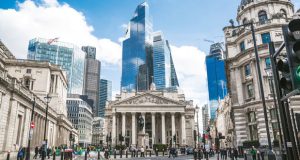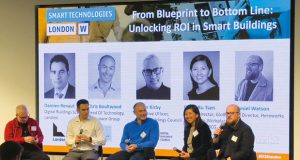DIGITAL INNOVATION
In his opening talk on the first main plenary session of the conference, The Networked World: Inclusive Infrastructure and Structural Economic Transformation, Guy Grainger, EMEA CEO at JLL told the summit: “We’re more digitally connected together, whether in personal or work life than ever before, yet the property industry is still working with 20th century systems in a 21st world. What are we going to do about that? We know that structural changes will take place to accommodate the new ways of working.
“Considering that the property sector has seen a lot of growth due to low interest rates, and a lot of capital expenditure there is a danger of an air of complacency coming to the industry. What are we going to do to respond?”
 The panel of speakers, which comprised Jonathan Ballon, Vice President and General Manager – Internet of Things, Intel Corporation, Ilya Espina de Marotta, Executive Vice President – Engineering and Programme Management, Panama Canal Authority and Wong Heang Fine, Group CEO, Surbana Jurong Pte discussed the possible impacts of digitalisation on both a developed world undergoing deindustrialisation, and on developing nations as they industrialise.
The panel of speakers, which comprised Jonathan Ballon, Vice President and General Manager – Internet of Things, Intel Corporation, Ilya Espina de Marotta, Executive Vice President – Engineering and Programme Management, Panama Canal Authority and Wong Heang Fine, Group CEO, Surbana Jurong Pte discussed the possible impacts of digitalisation on both a developed world undergoing deindustrialisation, and on developing nations as they industrialise.
Jonathan Ballon argued that technology is foundational in helping to increase productivity, and if used correctly has the potential to improve our societies and create employment. He also believes that the use of data and the insights this gives us will facilitate ways of improving our lives, both at home and at work.
The panel also explored the challenges of increased global urbanisation, as with three million people a week joining the city life, we all need more space to work and live. But what they pondered constitutes an attractive city to live in? Aside from cities like Dubai which in many ways is being designed from the ground up, what do we do about cities with heritage issues like Hong Kong or London?
Surely, they concluded this is a call to action for the Built environment to prove the true return on investment that buildings make to the environment, community and the customer?
CITY HUB
Urbanisation; from the development of future cities to the influence of clusters on work and life was the focus of the first of the breakout sessions at the summit.
In Clustering to Compete: Nurturing Innovation for Prosperity and Security, the panel discussed how clusters and specialisation sites such as tech or industrial hubs can boost regional economic prosperity. How can urban design, local skills bases, and public policy combine to establish optimal conditions for clusters that are attractive to investors? How can clusters accelerate the innovations needed to address the most pressing issues facing the built environment?
Margot Orr Jones, Director of Future Cities Development at Jacobs, says that clusters could be deemed old fashioned, but you could just as easily argue the opposite.
“One of the questions that came up when we discussed this topic was ‘is the idea of a cluster old fashioned?’ but then is a city a cluster itself, or a cluster of clusters? For me we all identify with innovation cluster or industrial cluster, but it isn’t about a theme, it’s about identifying a group of people who feed off each other in a virtuous circle. When I go out into the real world when we look at design from a cluster perspective it’s more likely it’ll get built because of this approach.”
One of the discussion points was whether a cluster be left to occur organically or is it something that can be created from scratch. In other words, is it nature or nurture?
However they develop argued Professor Richard Templer, Director of Innovation Grantham Institute, Imperial College London, people still had to be at the heart of any future design.
“I believe you need ways of bringing people together, places where they can meet formally but casually as well. For me, that’s about design, physical and geographical, where people can easily find opportunities.”
A similar theme ran thought the concurrent session, Cities in changing ecosystems of industry and commerce. This considered the implications for employers and employees of the impact of the fourth industrial revolution as technology leads to a more decentralised production and service delivery.
As James Chau the session chair phrased it: “Dubai is a very nice place to live, but compared to other cities like Hong Kong which is very dense and there is a common denominator in cities where they say the air is not great, the housing is not affordable, I can’t get fresh produce coming in – the green belt is too far away from me, is the success of a city just down to opportunities for work? Shouldn’t it also be about quality of life outside of the workplace?”
 That theme was explored further in the session on day two, How are cities getting smart? Which looked at ways cities can embrace the 21st century. During this event, Nicola Yates, CEO of Future Cities Catapult, noted that too many city planners thought about the future using today’s knowledge. She asked, had they thought about emerging technology, including 5G and the immersive experience? “We have to think about the impact of that on travel and on workforce locations,” she said.
That theme was explored further in the session on day two, How are cities getting smart? Which looked at ways cities can embrace the 21st century. During this event, Nicola Yates, CEO of Future Cities Catapult, noted that too many city planners thought about the future using today’s knowledge. She asked, had they thought about emerging technology, including 5G and the immersive experience? “We have to think about the impact of that on travel and on workforce locations,” she said.
She added that driverless cars and less personal mobility, like car sharing, may lead us to think about what to do with redundant car parks.
And swinging back to the keynote speech at the start of the conference, according to JB Straubel – drivers may still be faced with traffic jams in the age of the autonomous car, but it could be from empty vehicles being sent back out of the city centre to park.
Next year’s event will move to New York where the impact of digitisation on business, cities and the environment will be the theme. ww2.rics.org/uk/wbef/




